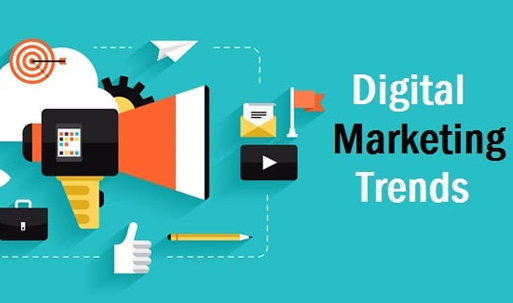Voice Search Is Taking Over
Almost one-third of the 3.5 billion searches performed on Google every day are voice searches now, with personal assistant devices leading the way. ComScore estimates, that by 2020, half of all search queries will be voice-based.
The advances made in recent years in the fields of natural language processing, conversation interfaces, automation, and machine learning and deep learning processes have enabled virtual assistants to become increasingly intelligent and useful.
Consumers are more excited about their smart speakers than ever. A 2017 report by NPR and Edison Research revealed that 42% of Americans called them “essential,” and their popularity is on the rise. This year’s version of the same report concluded that smart speakers are becoming a part of our daily lives and bringing dramatic changes to consumer behavior. More and more people use Amazon’s Alexa, Apple’s Siri and Google Assistant everyday.
As their capacity for recognizing human speech has improved significantly, they can be incredibly helpful in both searching for information on the Web and doing things around the house.
Voice search differs from the typical desktop or mobile search. When you open Google on your browser and type in your search query, you’ll see hundreds of pages of search results. It’s not that hard to be one of them. When you ask Siri a question, it will give you just a few results. More often than not it will only give you one result.
Therefore, tailoring your SEO strategy for voice search is crucial.
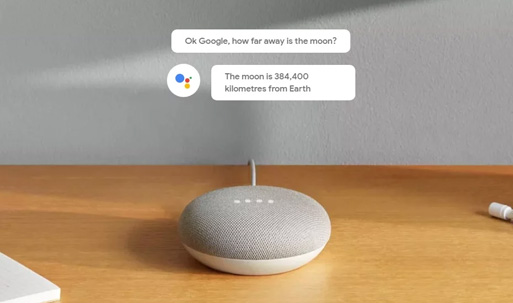
Ways you can do this is make your search phrases more conversational and less like written terms. Often written searches are just keyword bundles. Consider what your customers might speak, rather than type when making an inquiry. It also makes sense to start writing in a more conversational tone to develop content that better aligns with voice search.
Voice recognition technology is only expected to grow and to improve. It will bring a significant disruption to the marketing world. We always focused on SEO and optimization of UX and UI, but when there is no screen then these aspects become irrelevant. How will businesses adapt to these changes? For now, there is no real answers to this question.
What can you do as a business to prepare for this shift in search? I would suggest brainstorming on what immediate bits of information people most likely ask a voice search for – specifically for your business.
Some examples of specific voice searches would be…
- “How late is ‘Business XYZ’ open until today?”
- “What band is playing at ‘Bar XYZ’ tonight?”
- “How much is ‘Product XYZ’ at ‘Business XYZ’?”
- “Where is ‘Business XYZ’ located?”
- “Does ‘Business XYZ’ offer ‘Service XYZ’?”
- “Does ‘Restaurant XYZ offer delivery (or banquets?)”
- “What ‘Business XYZ’ location is closest to me?”
If you own a device with voice search, play with it for 10-15 minutes. Ask it questions about YOUR business and see how the results sound. They are probably pretty poor at this point since most businesses have yet to address voice search. Now try asking questions about larger companies with much larger marketing budgets like Apple, Best Buy, McDonald’s, etc and see if they are any better at handling voice search queries.
The idea is to be to adapt your website’s content to reflect these specific questions and provide clear answers in a way that search engines can easily understand, index, and repeat back in an intelligent and useful way.
Also be sure your Google Business listing is up to date for basic questions on location, phone number and business hours.
Understanding the nuances of voice search and implementing them into your marketing strategy will definitely be worthwhile in the long run.
AI is Replacing Humans
Artificial intelligence is the hot topic in marketing. Even though many still don’t understand it’s capabilities and limitations, the technology is taking a shape.
The most widely implemented form of AI are chatbots, which help brands to improve customer service while keeping a lid on budgets. Chatbots are quicker than humans in giving any data-related answers and taking requests. They have humor and personalities and offer personalized service to any customer in need, any time. Chatbots can be integrated with a website, an application, and even with a social media platform. They also gather user information that can later be used to better tailor marketing strategies.
A quality chatbot can answer open-ended questions and use natural language processing (NLP) and machine learning to find the best responses to frequently asked questions. Chatbots also maintain a standard level of customer service — never impatient, always friendly. Additionally, they can offer 24/7 client service while retaining data for later use.

Artificial intelligence is so good at offering information and tips to users by getting into conversations, that according to Gartner, 25% of customer service will use chatbot technology by 2020, up from less than 2% in 2017. It’s also estimated that in the next 5 years, approximately 80% of business communications with customers will be performed through bot messengers. That’s a hell of a lot of growth, and quickly.
Artificial intelligence will take over the world! Or at least the world’s simpler jobs. Businesses adopting AI in 2019 will be able to save costs and accelerate growth, getting an edge over their competitors. As a business owner, you need to decide if the cost-saving benefits of this technology are worth the cost of implementation. If you handle a large call center or are regularly bombarded with incoming calls and requests, this may be something to look into.
Be Authentic with Social Proofing
People are putting more trust in others they know and reputable content, not ads. As consumers are increasingly distrusting of advertising and marketing, not even authenticity – but brutal honesty is becoming critical for brands. At the end of the day, what clients really want is to understand your brand in order to trust it.
Every interaction you have, whether it’s online or in person, should contribute to your overall brand — a brand that is uniquely yours and is clear about what you offer and how you stand out from your peers. The undertone of honesty and authenticity can attract the types of clients with whom you’ll actually want to work and can make your content marketing initiatives far more successful. This is where Social Proof come into play, allowing your customers to tell your brand’s story in an honest and simple way.
Social proof is a psychological phenomenon where people assume the actions of others in an attempt to reflect correct behavior for a given situation.
According to Robert Cialdini, who studied the principle of social proof in-depth in his book, Influence: The Psychology of Persuasion, “we view a behavior as more correct in a given situation to the degree that we see others performing it”. So often in situations where we are uncertain about what to do, we would assume that the people around us (experts, celebrities, friends, etc.) have more knowledge about what’s going on and what should be done.
On top of that, we often make judgments based on our overall impression of someone. For example:
- We think anything that experts use is great because they are probably more knowledgeable than us in their area of specialization.
- We buy products endorsed by celebrities because we want to look like them.
- We trust user reviews because they have experienced the product or service, unlike ourselves.
In the past, it was mainly celebrities who influenced us, and they were paid handsomely for it. Today you can have massive groups of brand fans promoting your product/service on a social channel that has billions of viewers, and it may not cost you a dime.
If you go to a nightclub or bar’s website and see professional photos of people having a time of their lives – you want to be there. If you see a video on social media of a group of folks having fun with a certain product – you want to buy that product as well. This is similar to what commercials do, but it is not scripted and the actors are not paid. It is REAL people having a REAL experience with your brand, and that is powerful stuff.
Leveraging UGC (User Generated Content) is a fantastic way to promote social proof and gain trust with your customers. This means letting your customers and fans tell the world about your product or service in their own way.
One of the greatest examples of how to use UGC (User Generated Content) is provided by GoPro. There are almost 5000 videos posted online each day with the #GoPro hashtag – from cliff diving and vertical skydiving to filming wild nature and eco-friendly initiatives. How did they manage to grow such engagement? While their competitors’ content simply talks about waterproof lenses and megapixel levels, GoPro’s content glorifies passion, inspires and fills with awe. Through trusted and engaging UGC, used throughout their multichannel marketing efforts, they win consumers hearts (and wallets).

Make an effort to motivate your customers to share their experiences with your brands. It will definitely pay off, as consumers are three times more likely to say that content created by a consumer is authentic compared to content created by a brand.
Video Marketing is Still Strong
Video is still winning the race of most successful medium of marketing in 2018 and this is set to continue into 2019. This makes sense, because the average attention span of consumers is short, and most people would rather watch a video than read a blog post.
Live video is gaining popularity, with a large number of businesses using it for interviews, product demos and “behind the scenes” glimpses of events, life in the office, how products are made, etc. And don’t just think YouTube. To witness higher engagement with your video marketing, you can make a video post or start a live broadcast on Facebook, Instagram or LinkedIn.
Numbers don’t lie.
- 70% of consumers say that they have shared a brand’s video.
- 72% of businesses say video has improved their conversion rate.
- 52% of consumers say that watching product videos makes them more confident in online purchase decisions.
- 65% of executives visit the marketer’s website and 39% call a vendor after viewing a video.
- YouTube is the 2nd most used search engine in the world (Google text search is #1)
With ever-decreasing costs of film equipment and the increasingly high-quality smartphone cameras, businesses and marketers are heading for personalized video messages rather than phone calls or emails.
Live video has been a large factor in marketing because it directly connects engaged consumers to products and services. If you want to catch consumer attention then you will most likely find them on social media. Platforms like Facebook Live have given marketers the opportunity to be in the face of their target market.
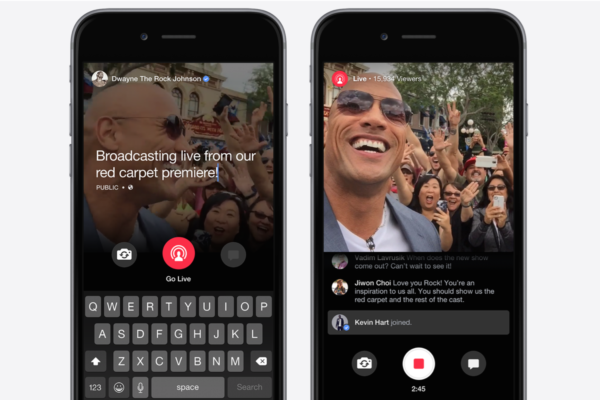
Next year, live video feeds will continue to explode, but the important aspect going forward will be originality. Interactive video and imaginative video marketing that encourages user engagement will quickly outpace video for the sake of moving pictures. Consumers become bored quickly — brands that use video to engage and excite users will win.
The importance of video cannot be understated according to Hubspot. Simply adding a video to an email boosts click-through rate by a staggering 200–300 percent, and putting one on a landing page increases conversion rate by 80 percent.
YouTube and other videos are now displayed in the SERPs (Search Engine Results Pages), so video SEO (Search Engine Optimization) is becoming much more important – like using text overlays and closed captions, in addition to your description, title and file names.

So make sure you don’t fall behind in video arena. In almost every area of marketing, it outperforms other mediums. Look at your business activities and work out the best way to get video marketing incorporated into your strategy.
Social Messaging Apps are All the Rage
Think social messaging apps are just for sending emojis to your friends?
Consider these numbers:
- 1.3 billion monthly users are active on Facebook Messenger
- 2 billion messages are sent between people and businesses on Facebook Messenger every month
- WhatsApp has 1.3 billion monthly active users
- 55 billion messages are sent via WhatsApp every day
- WhatsApp, Facebook Messenger, and WeChat have more combined users than Facebook or YouTube
These statistics show the growing popularity of social messaging apps for business purposes. Since people are spending more of their time messaging each other, it makes sense to market your company’s services where your potential customers are hanging out.
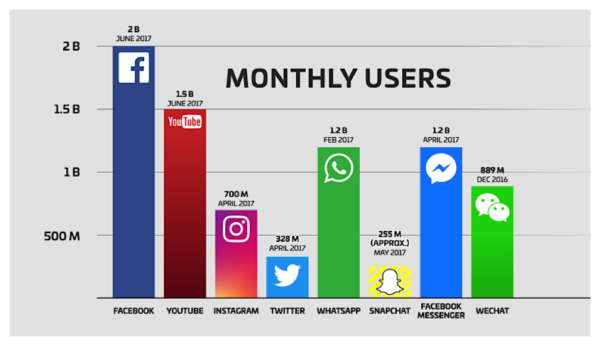
Social messaging apps can be very useful in sending messages to customers directly, as they allow personalization (another trend) and add value to the users’ experience. This differs from the messenger chatbots we discussed earlier. You’re actually able to market to customers using messaging apps now!
Micro-Moments Are Taking Over A Consumer Journey
Today’s consumers are bombarded by content, ads, offers, emails, push notifications and everything else. All the time. We have reached the point, where we simply cannot process any more information. As U.S. consumers already spend 3 hours 35 minutes per day on their smartphones (eMarketer), brands and marketers have a really hard time attracting the attention of their audience. That’s where micro-moment marketing steps in.
The micro-moment is a new type of consumer behavior, which occurs when people reflexively turn to a device, usually a smartphone, to act on a need to learn something, do something, get to know something or buy something. There are a lot of different types of micro-moments such as I-want-to-know moment, I-want-to-go-moment, I-want-to-do moment or I-want-to-buy moment. According to Google’s content marketing team, Think with Google, users experience “micro-moments” on average 150 times a day.
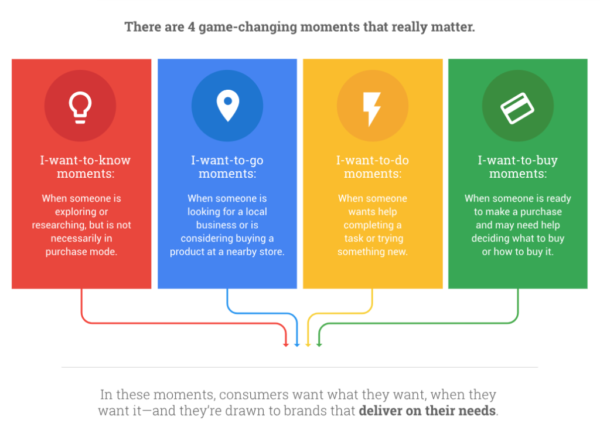
Why are micro-moments so important? Because people, in general, make instant decisions on what to buy, where to go or which restaurant to eat at, which gives you a span of only seconds to catch their attention. Micro-moments work, because they provide consumers with the right information exactly when they need it.
Ultimately, the whole consumer decision journey is a combination of these micro-moments across all channels and devices. The successful brands of tomorrow will be those meeting their consumers’ needs in these micro-moments.
To learn more about Micro-Moments, visit Google’s page – https://www.thinkwithgoogle.com/marketing-resources/micro-moments/
Author
TJ Swing
Founder and President, Zagrun Marketing


